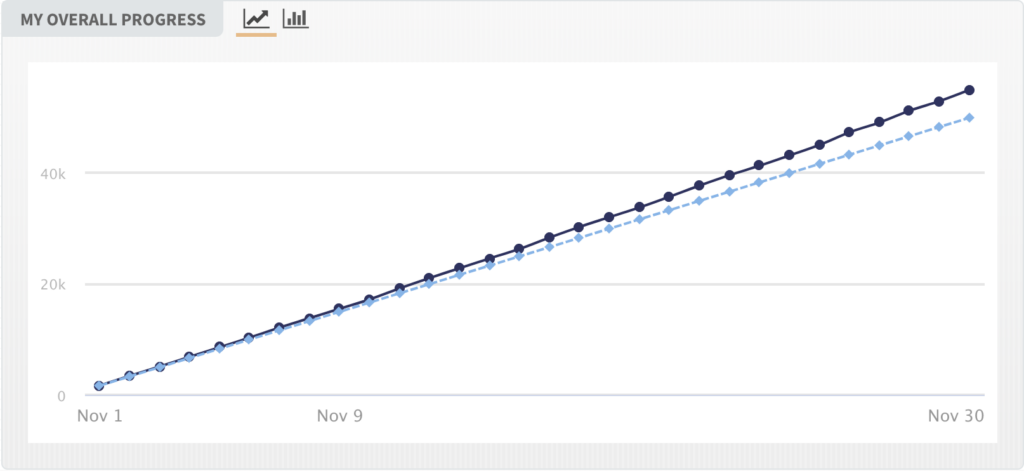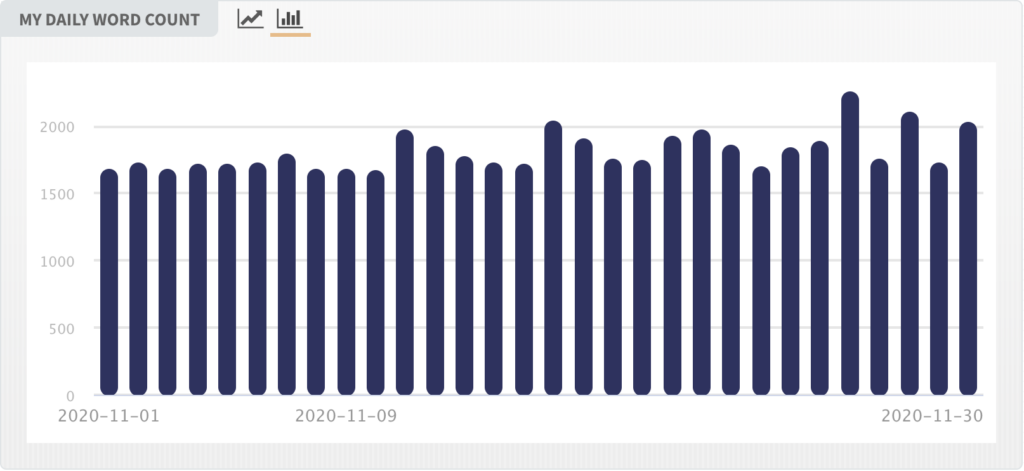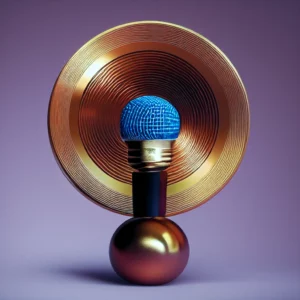NaNoWriMo – Day 30
Today is the final day of NaNoWriMo. I added about 2000 more words to my novel-in-progress this morning. My final word count for the month came in at 55,051 words. The challenge of NaNoWriMo (National Novel Writing Month) is to write 50,000 words of a new novel in 30 days, so I exceeded this target by about 10%.
Here’s my daily progress log, showing my total word count (darker color) versus the daily pacing needed to hit 50K words (lighter color).

I surpassed the target pacing by a small amount on Day 1 and then padded my lead every day afterwards. It felt good to always be a little bit ahead throughout the challenge. I knew that if I just maintained this steady pacing, I’d never need to do any catch-up writing at the end.
Before starting this challenge, I learned that a major reason people fail at NaNoWriMo is that they fall behind in the first couple of weeks, and then they feel disheartened when facing the extra effort needed to catch up. Even skipping one day means you’ll have to write more in the remaining days. Most people who fall behind give up and don’t complete the challenge. This is an easily preventable point of failure.
My strategy was to approach this as a daily challenge, which plays to my strengths. I’ve done lots of 30-day challenges where I practice a specific behavior for 30 days in a row. In this case the desired behavior was to add at least 1667 words to my novel each day. If I just focused on that, the monthly goal would be accomplished too. It’s just typing after all.
Here’s what my daily word count looked like for all 30 days.

As you can see, I was pretty consistent throughout the month.
I averaged 1835 words per day, which works out to an extra 10% per day. Once I passed the 1667 words for the day, I kept writing till I felt like stopping, such as when I got to the end of a scene. If I felt like stopping but I wasn’t at 1667 words yet, I took a short break and then continued writing.
Final Reflections
This was a wonderful personal growth experience, and I’m glad I did it. The novel isn’t done and will need a lot of work to finish, but the daily writing got me well into the project.
I don’t have a completed book yet, and it would take a lot more work to drive this towards a version ready for publishing, but NaNoWriMo got me moving forward with meaningful progress. It helped me turn a mere idea into something a lot more tangible.
At this point I don’t have a completed story. I’ve written a first draft of many scenes. I have several well-developed characters. I have a well-structured three-act story with interesting plot twists. But there are still many more details to work out.
This is a very rough first draft. I’d say it’s not bad for a month’s work. I estimate that I averaged about 75 minutes per day of writing time (including thinking about what to write). I’m very pleased with how far I got for about 40 hours of effort. There was also some incubation time when I’d be thinking about characters or plot ideas while doing unrelated tasks.
The “words are cheap” mindset worked very well. It’s easy to throw words onto the screen, read them back the next day, and learn something useful. I’ll end up throwing away much of what I wrote this month, and I don’t lament that at all. Everything I wrote helped in some way. Each day I gained more clarity about the story, the characters, and the world. Even when what I wrote seemed like a chaotic mess, it still felt like forward progress.
Other writers have said that you write the first draft for yourself, not for anyone else. I adopted that mindset from Day 1, and I found it very helpful. I didn’t expect to show this early draft to anyone, not even Rachelle. So I just wrote whatever came to mind. It was my own personal exploration of the ideas and possibilities, nothing more. By framing it that way, I felt totally free to experiment and to make lots of mistakes. This helped me figure out what kind of story I wanted to tell. I let the words flow without any concern about who might read them.
One clear gain was that I understand my characters so much better than when I first started. Now I can write their words and actions much more easily, as if they tell me what they would say and do in every situation. So the writing got easier as I went along. The first few days were the most challenging; after that it was smooth sailing.
Another gain was that my “why” for writing this story improved as I kept writing. Around halfway through the month, I developed a stronger sense of purpose for why I wanted to write and share such a story. I had a more compelling answer to the questions: Why bother with this project? What’s the point? Who would want to read this? My purpose was more exploration-based in the beginning, but by the end I felt like I was creating something I really wanted to share with the world to see how it landed with people. I had a clearer sense of the story’s potential impact.
This was similar in some ways to designing a new video game from scratch, but the medium is very different. I liked how easy it was to explore the characters, story ideas, and world without having to deal with tech constraints. I could play around with any ideas I could imagine. I really enjoyed that type of experience – it was like pure play.
Most days I looked forward to my writing sessions. I didn’t experience much inner resistance after the first week, and that small resistance was just due to being too green at this type of writing. I think having lots of nonfiction writing experience – and a healthy willingness to make plenty of mistakes – was helpful. I never had writer’s block. I could connect with inspired ideas for fiction writing as easily as for nonfiction articles or courses.
Next Steps
I’m going to set aside the novel writing and coast into a more relaxed December since I want to focus on other aspects of life for the rest of the year. That includes finishing up my one-year daily blogging challenge, which has 31 days left to go.
Stephen King recommends setting aside a novel for at least 6 weeks after writing the first draft and then coming back it to fresh. He says it’s wise to get some distance from the story, so you can see it with fresh eyes before you start editing.
My first draft isn’t good enough that I can just edit it into a finished book. It’s way too messy for that, especially since there are a lot of scenes I’ll need to cut or rewrite differently. I’m still going to set this aside for 6+ weeks, probably until after our next deep dive is complete, but my next steps will be different than Stephen King’s.
Sometime next year I’d like to revisit this novel project, re-read everything I wrote, and then begin working on a second draft. I’d like to do a round of more detailed plotting before I add more words to the book. I think the story would benefit a lot by clarifying the scene-by-scene layout.
The pantser approach was great for getting started since it helped me map out the possibility space for the story by writing a lot of scenes. Now I have enough understanding of the story and characters that a good next step would be to map out the scenes for the story in the right order. I’d also like to fill out character and location sheets to fine-tune the characters and settings. Then I can write the second draft.
It’s going to be a long process, and I’m not in a rush to race through this. I do want to see this through to publishing. It’s an original story with some fun characters that I think people would enjoy reading. I might approach this project as a series of 30-day challenges to push it forward through different stages of development.
I’m happy that I framed NaNoWriMo in a way that made the experience enjoyable, especially by always being ahead of schedule. This makes me eager to re-engage with the novel when I’m ready. There are other priorities I want to engage with next, so I’m happy to put this aside for now, but I do look forward to getting back into it with fresh eyes.
Our Next Deep Dive
My first big priority for 2021 is to launch and develop our new creative productivity deep dive, which is tentatively called Amplify. This is for people who do creative work and want to increase their productive output. It’s also for people who’d like to get into a better creative flow. You could think of it as a course in how to be a prolific creator who publishes frequently. How can you express yourself creatively year after year without burning out?
I have tons to share about this topic that I believe would be unique and different from anything else out there. I’ve gone through many books and courses on creativity and on productivity, but I still haven’t seen really good coverage regarding connecting the dots between creativity and productivity. It’s like creativity is play, and productivity is work. There’s a lot of conflicting advice that treats creativity as inherently unproductive and productivity as inherently uncreative.
What if you want to excel at both together? What if you want to be a fountain of creative expression?
How can you be super creative and highly productive without sacrificing too much on either side? How can you get into the flow of creating and publishing – and stay there consistently without burning out?
There’s a lot to unpack here, and I’m convinced that this is an area where I can add some real value to people’s lives. I’ve created and published across many different media: articles, videos, podcasts, a book, video games, music, live events, and more. This year I’ve published something new every single day, adding hundreds of thousands of words to my collective work, which is already well into the millions of words, not counting translations into other languages.
I love to keep exploring new media too, such as I just did with NaNoWriMo. Partly I did NaNoWriMo as an experiment to test some of the ideas for this upcoming deep dive.
I’d love to do this new deep dive co-creatively too, like we did with our previous ones, so the lessons will be created as we go, designed for the specific needs of the people who enroll.
I haven’t decided on the exact the format yet. My intuition says it will likely be something different from our previous courses, perhaps a combination of live interactive parts along with structured audio lessons. People loved the audio format of Submersion and Stature, and there was also something special about the live sessions that we did for Deep Abundance Integration. So I’m thinking of merging those for the new deep dive. Would that appeal to you?
I’ll share more info on this new deep dive next year as we get closer to launching it. We’ll be launching it during the first quarter of 2021. I tend to get an intuitive ping when the timing is right for launching. In the meantime, I’d like to clear my plate of some other projects first, mostly on the personal side.




